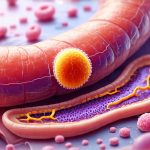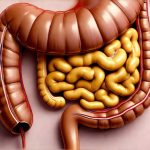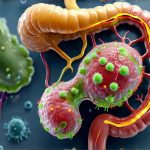The gut, often referred to as our ‘second brain’, is far more than just a digestive tract. It’s a complex ecosystem where trillions of microorganisms – bacteria, fungi, viruses, and others – live in a dynamic relationship with our bodies. This intricate community profoundly influences everything from immunity and mental health to energy levels and, crucially, nutrient absorption. A healthy gut environment relies on a delicate balance, and one key aspect of this is maintaining appropriate acidity levels. Disruptions to this balance can lead to malabsorption, digestive discomfort, and potentially long-term health issues. Understanding how our dietary choices impact gut acidity is the first step towards optimizing our overall well-being.
Many factors contribute to imbalances in gut acidity, including stress, antibiotic use, and, significantly, our diet. Modern diets often lean heavily on processed foods, refined sugars, and lacking fiber – all elements that can negatively affect the gut’s delicate pH balance. Restoring this balance isn’t about drastic changes or restrictive diets; it’s about making informed choices that support a thriving gut microbiome and enhance our body’s ability to extract vital nutrients from the food we eat. This means focusing on foods that naturally promote healthy acidity, incorporating prebiotics and probiotics, and understanding how food combinations can either aid or hinder digestion and nutrient uptake. If you struggle with discomfort during sensitive days, consider exploring how to balance nutrition.
The Science of Gut Acidity & Digestion
Gut acidity isn’t a static value; it varies along different sections of the digestive tract. The stomach boasts a highly acidic environment (pH 1.5-3.5), crucial for breaking down proteins and killing harmful pathogens. As food moves into the small intestine, pH gradually increases to around 7-8 thanks to secretions from the pancreas and gallbladder – this creates an optimal environment for nutrient absorption. The large intestine is slightly less acidic, allowing beneficial bacteria to thrive. Maintaining this gradient of acidity is vital for efficient digestion and a healthy gut microbiome. When stomach acid production is insufficient (hypochlorhydria), or when the gut becomes overly alkaline due to dietary factors, it disrupts this process. Understanding how GERD affects appetite can also shed light on these processes.
A compromised acidic environment in the stomach can lead to several issues: undigested food ferments, causing bloating and gas; protein breakdown is incomplete, potentially leading to allergies and sensitivities; and absorption of essential minerals like iron, calcium, and zinc is significantly reduced. Furthermore, a less acidic gut allows harmful bacteria to proliferate, contributing to dysbiosis – an imbalance in the gut microbiome. Conversely, excessive acidity can irritate the gut lining and damage beneficial bacteria. The goal isn’t necessarily to “increase” or “decrease” acidity overall; it’s about restoring the natural pH gradient and supporting a healthy digestive process throughout the entire system.
A key factor influencing gut acidity is hydrochloric acid (HCl) production in the stomach. This production can be affected by factors like age, stress levels, and dietary habits. Chronic stress depletes resources needed for HCl synthesis, while highly processed diets lack the nutrients required for optimal digestive function. Therefore, a holistic approach considering lifestyle alongside diet is essential for restoring gut health. It’s important to remember how to keep gut health simple in your daily routine.
Dietary Strategies to Support Balanced Acidity
The foundation of balanced gut acidity lies in prioritizing whole, unprocessed foods. This means focusing on nutrient-dense options that provide building blocks for healthy digestion and support the growth of beneficial bacteria. Incorporating fermented foods like yogurt (with live cultures), kefir, sauerkraut, kimchi, and kombucha introduces probiotics – live microorganisms that contribute to a diverse and balanced gut microbiome. Prebiotic fibers found in foods like onions, garlic, asparagus, bananas, and oats feed these beneficial bacteria, enhancing their growth and activity. Think of prebiotics as food for your probiotics.
Beyond fermented foods and prebiotic-rich options, certain dietary patterns naturally support healthy acidity. For example, a Mediterranean diet – rich in fruits, vegetables, olive oil, lean proteins, and whole grains – provides ample nutrients and fiber while minimizing inflammatory processed foods. Conversely, limiting sugar intake is crucial, as excessive sugar feeds harmful bacteria and disrupts the gut microbiome’s balance. Similarly, reducing consumption of highly processed foods, artificial sweeteners, and excessive alcohol can significantly improve gut health. It’s also important to consider how we eat, not just what we eat – mindful eating practices like chewing food thoroughly aid digestion and reduce stress on the digestive system. Balancing gut healing with social life can be challenging but rewarding.
Optimizing Food Combinations for Better Digestion
Food combining is a dietary approach that suggests certain foods digest more efficiently when eaten together, while others can hinder digestion and lead to discomfort. While not universally accepted by mainstream nutritionists, many individuals find it helpful in managing digestive issues. The premise is based on the fact that different food groups require varying levels of acidity for optimal breakdown – combining foods with conflicting digestive requirements can overwhelm the system.
- Avoid combining large amounts of protein and carbohydrates in the same meal. Protein requires an acidic environment to digest, while carbohydrates require alkaline conditions. This combination can neutralize stomach acid, impairing protein digestion and leading to fermentation.
- Separate fruits from other food groups. Fruits digest quickly and are best consumed on an empty stomach or as a snack. Eating fruit with meals causes it to ferment in the gut, resulting in gas and bloating.
- Combine foods that naturally complement each other. For example, pairing lean protein with non-starchy vegetables provides essential nutrients without overwhelming the digestive system.
These principles aren’t about strict rules but rather guidelines to help optimize digestion based on individual tolerance. Experimenting with different food combinations can reveal what works best for your body. Remember that individual responses vary.
Addressing Low Stomach Acid Naturally
Many people unknowingly suffer from low stomach acid (hypochlorhydria). Symptoms include bloating, gas, indigestion, nutrient deficiencies, and even fatigue. While medication can sometimes be used to address this issue, several natural strategies can help stimulate HCl production.
- Apple Cider Vinegar (ACV): Consuming 1-2 teaspoons of raw, unfiltered ACV diluted in water before meals may help increase stomach acidity. Caution: ACV is acidic and should be diluted properly.
- Ginger: Ginger has been shown to stimulate digestive enzymes and promote HCl secretion. Incorporate fresh ginger into your cooking or enjoy ginger tea before meals.
- Bitter Greens: Consuming bitter greens like arugula, dandelion greens, and radicchio stimulates digestive juices, including stomach acid. Include these in your salads or as a side dish.
It’s crucial to identify the underlying cause of low stomach acid. Stress management techniques like meditation, yoga, and deep breathing exercises can reduce stress hormones that inhibit HCl production. Additionally, ensuring adequate intake of zinc and B vitamins – essential for digestive function – is vital. If symptoms persist despite these efforts, consulting a healthcare professional is recommended. It’s also helpful to understand how to balance gut acidity as it relates to overall health.
Hydration & The Role of Water
Staying adequately hydrated is often overlooked but plays a crucial role in gut health and nutrient absorption. Water helps maintain the mucosal lining of the digestive tract, facilitating smooth food passage and preventing constipation. It also aids in the breakdown of food and the transport of nutrients across the intestinal wall. Dehydration can lead to increased gut viscosity, making it harder for enzymes to function effectively and reducing nutrient uptake.
- Aim for at least 8 glasses of water per day, adjusting based on activity level and climate.
- Sip water throughout the day rather than drinking large amounts at once.
- Consider incorporating hydrating foods like cucumber, watermelon, and celery into your diet.
- Avoid sugary drinks and excessive caffeine, which can dehydrate the body.
Proper hydration isn’t merely about quantity; it’s also about quality. Filtered water is preferable to tap water, which may contain chlorine and other chemicals that disrupt gut health. Ultimately, prioritizing adequate hydration is a simple yet powerful step towards supporting balanced gut acidity and optimizing nutrient absorption. Supporting gut transit and reducing pressure can greatly improve your overall wellbeing.


















